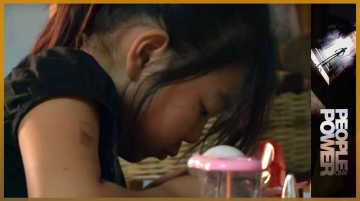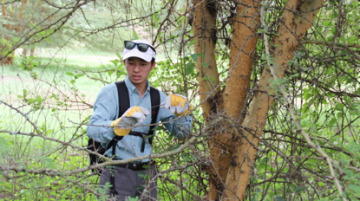 The controversial 2007 Sicomines infrastructure-for-natural resources deal between China and the Democratic Republic of the Congo is a milestone in Sino-Africa ties as it’s one of the largest agreements of its kind on record. Originally valued at 9 billion dollars (it has seen been reduced), the deal stunned many in the West, particularly at the International Monetary Fund, as it was widely interpreted as a direct challenge to the half-century old order that governs Western management of aid and development assistance in Africa.
The controversial 2007 Sicomines infrastructure-for-natural resources deal between China and the Democratic Republic of the Congo is a milestone in Sino-Africa ties as it’s one of the largest agreements of its kind on record. Originally valued at 9 billion dollars (it has seen been reduced), the deal stunned many in the West, particularly at the International Monetary Fund, as it was widely interpreted as a direct challenge to the half-century old order that governs Western management of aid and development assistance in Africa.
For more on why the Sicomines deal is so controversial and how it was portrayed in the Western media, watch BBC Newsnight’s special coverage: part 1, part 2 and part 3.
Johanna Jansson is a Phd candidate at Roskilde University in Demark and among the world’s leading scholars on China’s resource extraction policies in Africa, particularly in the DRC and Gabon. Jansson has done considerable field research in the DRC where she spent much of 2011 working on a research paper on the subject for the South African Institute of International Affairs: “The Sicomines Agreement: Change and Continuity in the Democratic Republic of Congo’s International Relations” (download PDF).
CHINA AFRICA PROJECT: The Sicomines deal is often held up as an example of the power of the Chinese government’s drive to secure natural resources in Africa. While many believe these deals emanate from a coordinated policy decision at the political level in Beijing, you contend it isn’t that straight forward. If the government isn’t ‘ordering’ this type of massive investment in the DRC then where does it come from?
JOHANNA JANSSON: The Chinese government knows very well that it needs to secure access to resources to keep its economy going. This was one of the key motivations behind its 2001 Going Global Strategy, called zou chu qu in Mandarin. The essence of this strategy was that China’s state-owned enterprises, the SOEs, were encouraged to ‘go out’. Besides securing access to resources, the other key motivations for the Going Global Strategy were to gain experience and become competitive globally, and to gain market traction for Chinese exports. Now, we must remember that the relations between the Chinese state and China’s state-owned companies are greatly complex. The Going Global Strategy does guide the Chinese SOEs’ operations abroad in a broad sense. But the expansion strategies pursued by each company, and other types of decisions these companies take, are determined mainly by commercial considerations. As a matter of fact, the SOEs often fiercely compete with each other, also in African countries.
Before discussing the Sicomines agreement as an indirect embodiment of the Going Global Strategy in the DRC, I’d like us to take a step back and contextualise China’s foreign policy ambitions. China is not the only country pursuing goals such as those formulated in the Going Global Strategy. On the contrary, these are central foreign policy consideration for most countries. Let’s take a few examples. Securing access to oil is, as we all know very well, of paramount importance to the United States. France is actively supporting its nuclear giant Areva in its endeavour to secure access to uranium in Africa. As Senate Testimony on China in Africa in November last year aptly illustrates, American politicians are seriously worried that the inroads of Chinese consumer goods to African markets threaten, not African, but American jobs, since they take over the potential markets for American products. My take on China’s foreign policy endeavour, both globally and towards Africa, is therefore that it must be understood as part and parcel of the game of the contemporary global political economy.
 Now, let’s return to the Sicomines agreement in the DRC. I argue that it should not be understood as the result of a direct order by the Chinese government. Yes, it is a result of the Going Global strategy, but less directly so than is often believed. This has to do with the dynamics of state-company relations in China that I mentioned earlier. Indeed, the large companies involved in the agreement are owned by the Chinese state. Yet the Sicomines agreement was not initiated by the Chinese government, but by the state-owned enterprise China Railway Engineering Corporation, or CREC. CREC is one of the world’s largest construction companies, and it identified the concessions in the DRC as it was in the process of implementing its diversification strategy to expand into resource extraction activities. There are two links between the Sicomines agreement and the Going Global Strategy. The first is that CREC’s pursuit for global markets was triggered by it at the onset. The second is that the credit lines extended by China Exim Bank are one of the most important tools to implement the Going Global Strategy. The credit line extended to the DRC was of major political importance in ensuring that CREC got access to the concessions in the DRC, where decisions to allocate concessions are taken on opaque grounds. China Exim Bank’s support indicates that the Chinese leadership regards CREC’s expansion into the DRC as a highly important strategic move.
Now, let’s return to the Sicomines agreement in the DRC. I argue that it should not be understood as the result of a direct order by the Chinese government. Yes, it is a result of the Going Global strategy, but less directly so than is often believed. This has to do with the dynamics of state-company relations in China that I mentioned earlier. Indeed, the large companies involved in the agreement are owned by the Chinese state. Yet the Sicomines agreement was not initiated by the Chinese government, but by the state-owned enterprise China Railway Engineering Corporation, or CREC. CREC is one of the world’s largest construction companies, and it identified the concessions in the DRC as it was in the process of implementing its diversification strategy to expand into resource extraction activities. There are two links between the Sicomines agreement and the Going Global Strategy. The first is that CREC’s pursuit for global markets was triggered by it at the onset. The second is that the credit lines extended by China Exim Bank are one of the most important tools to implement the Going Global Strategy. The credit line extended to the DRC was of major political importance in ensuring that CREC got access to the concessions in the DRC, where decisions to allocate concessions are taken on opaque grounds. China Exim Bank’s support indicates that the Chinese leadership regards CREC’s expansion into the DRC as a highly important strategic move.
The Western view is that in a country like the DRC, development is more likely to occur where corruption has been reduced. A common Chinese view is the opposite: in a desperately poor country like the DRC, corruption will be reduced when economic development comes about.
CAP: When the Sicomines deal was first unveiled in 2007, it was widely interpreted as a rebuff to traditional donors (US, EU, IMF, etc…) in place of an alternative, less interventionist development partner in Beijing. Was this in fact the case?
JJ: Before responding to that question, I would like to stress that China is not likely to ‘take over’ as a donor to the DRC any time soon. The Western donors and the multilaterals remain very important to the DRC. Regarding the approaches, yes, they differ. In two main ways.
First, the Chinese government is not interventionist. Some Western donors work in the DRC although they have no bilateral aid agreement with the country. One example is my own home country Sweden, which does not give bilateral aid since it does not deem the situation in terms of corruption and aid efficiency satisfactory. China would never do that. Even though its non-interference policy has softened somewhat over the past two decades, it remains firmly committed to it. It is rooted strongly in China’s own experience during the ‘century of humiliation’ from the first opium war in 1839 to Mao’s proclamation of the People’s Republic of China in 1949.
The second point follows from the first. China’s support to the DRC is quite different from that of the West. A great deal of the Western donor community’s work in the DRC concerns capacity building in terms of justice, rights and transparency. These are, for well-known reasons, not the main concerns of the Congolese government. China only provides support that is in line with the host government’s priorities, both because of its non-interference stance, but also because it interprets the relation between ‘corruption’ and ‘development’ quite differently from the West. The Western view is that in a country like the DRC, development is more likely to occur where corruption has been reduced. A common Chinese view is the opposite: in a desperately poor country like the DRC, corruption will be reduced when economic development comes about. A well-placed Chinese respondent explained to me that the Chinese party in the Sicomines agreement is well aware of the corruption problems in the DRC. However, the respondent said, it is better to engage and improve the country’s possibilities for economic development through infrastructure refurbishment, since economic development in turn will reduce corruption.
Many listeners will now object and say that these explanations do nothing more than hide the geo-strategic reasons for China’s conduct in the DRC. This is not wrong, in the sense that all external actors have strategic reasons for being active in the DRC. Not all of them have direct interests in the Congo’s resources – many donors provide aid for autobiographical reasons, for example. As regards China, it has always been explicit about its own interest in the DRC’s minerals. But beyond the geo-strategic dimension, anyone interested in really understanding why China does what it does in the DRC needs to take the different interpretations of ‘interference’ and ‘governance’ into account.
CAP: Who has more at risk in the current configuration of the Sicomines deal, the Congolese or the Chinese?
JJ: The DRC is a risky place. It is highly volatile politically. The elections in November 2011 were rife with fraud, as reported by International Crisis Group among others. As we speak in March 2012, uncertainty after the elections, as well as the recent death of the President’s chief adviser Augustin Katumba Mwanke, put a break on activities for all investors, as reported by Reuters. Any analysis of the Sicomines agreement has to take this into account.
As to the question of who carries the risk in the current configuration of the Sicomines deal, the views diverge. Some, including the Chinese parties to the deal, argue that given the volatile political environment and the removal of the guarantee for the returns on the investment into the mining operation, the risk is now on the Chinese side. Others argue that while the exact quantities of minerals contained by the concessions allocated to the Sino-Congolese consortium are uncertain, it is beyond a doubt sufficiently large to repay the loans extended by China Exim Bank. I think that given the situation in the DRC, it is difficult to claim the one or the other with certainty. Yes, the Chinese take an enormous risk. If the credit line towards infrastructure is fully disbursed, then China Exim Bank will have ploughed US$ 3 billion into infrastructure projects in the DRC – a big loss if it turns out that the concessions are not worth enough and the Congolese government cannot pay. But one also has to be clear about the fact that investors are interested in the DRC’s mining sector because the potential returns are enormous. A representative for one mining company told me that at the same mining cost, they have a 5 percent return rate in the DRC, and 0.5 percent return rate in another operation in the developed world. It’s not difficult to see, then, why companies put up with all the hassle of operating in the DRC. Higher stakes, higher returns. In other words, I would caution against any decisive conclusions in terms of the risk at this point.

 The
The  Now, let’s return to the Sicomines agreement in the DRC. I argue that it should not be understood as the result of a direct order by the Chinese government. Yes, it is a result of the Going Global strategy, but less directly so than is often believed. This has to do with the dynamics of state-company relations in China that I mentioned earlier. Indeed, the large companies involved in the agreement are owned by the Chinese state. Yet the Sicomines agreement was not initiated by the Chinese government, but by the state-owned enterprise China Railway Engineering Corporation, or CREC. CREC is one of the world’s largest construction companies, and it identified the concessions in the DRC as it was in the process of implementing its diversification strategy to expand into resource extraction activities. There are two links between the Sicomines agreement and the Going Global Strategy. The first is that CREC’s pursuit for global markets was triggered by it at the onset. The second is that the credit lines extended by China Exim Bank are one of the most important tools to implement the Going Global Strategy. The credit line extended to the DRC was of major political importance in ensuring that CREC got access to the concessions in the DRC, where decisions to allocate concessions are taken on opaque grounds. China Exim Bank’s support indicates that the Chinese leadership regards CREC’s expansion into the DRC as a highly important strategic move.
Now, let’s return to the Sicomines agreement in the DRC. I argue that it should not be understood as the result of a direct order by the Chinese government. Yes, it is a result of the Going Global strategy, but less directly so than is often believed. This has to do with the dynamics of state-company relations in China that I mentioned earlier. Indeed, the large companies involved in the agreement are owned by the Chinese state. Yet the Sicomines agreement was not initiated by the Chinese government, but by the state-owned enterprise China Railway Engineering Corporation, or CREC. CREC is one of the world’s largest construction companies, and it identified the concessions in the DRC as it was in the process of implementing its diversification strategy to expand into resource extraction activities. There are two links between the Sicomines agreement and the Going Global Strategy. The first is that CREC’s pursuit for global markets was triggered by it at the onset. The second is that the credit lines extended by China Exim Bank are one of the most important tools to implement the Going Global Strategy. The credit line extended to the DRC was of major political importance in ensuring that CREC got access to the concessions in the DRC, where decisions to allocate concessions are taken on opaque grounds. China Exim Bank’s support indicates that the Chinese leadership regards CREC’s expansion into the DRC as a highly important strategic move.

